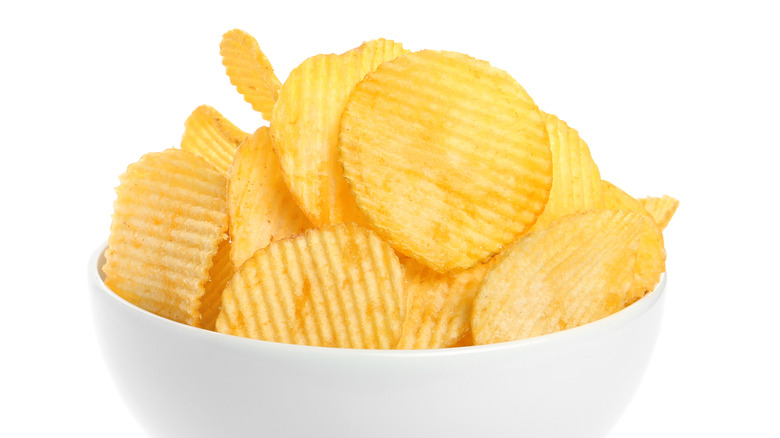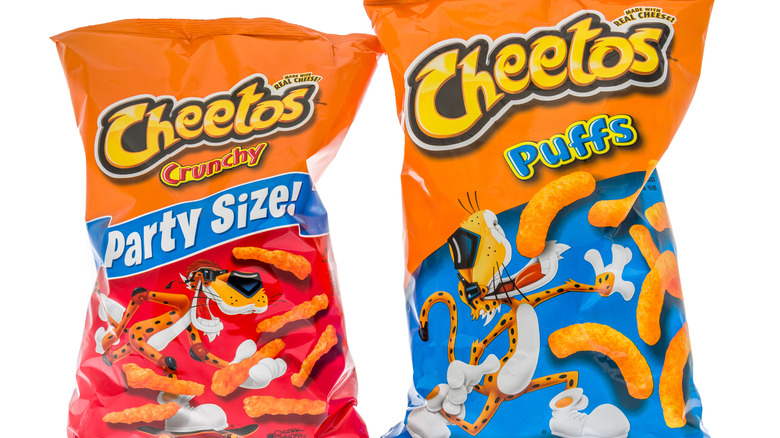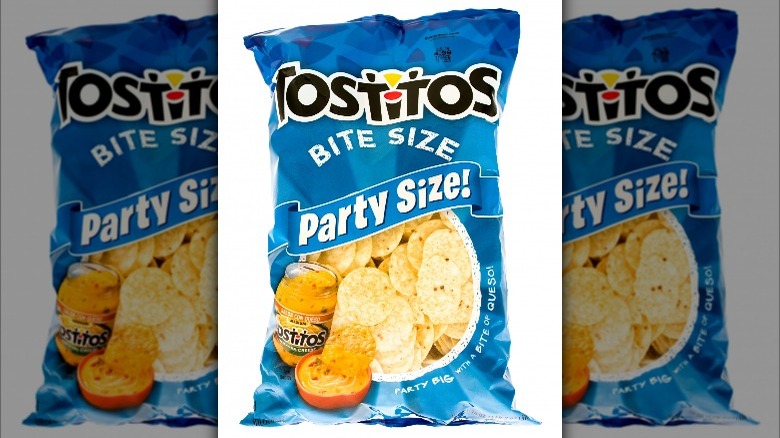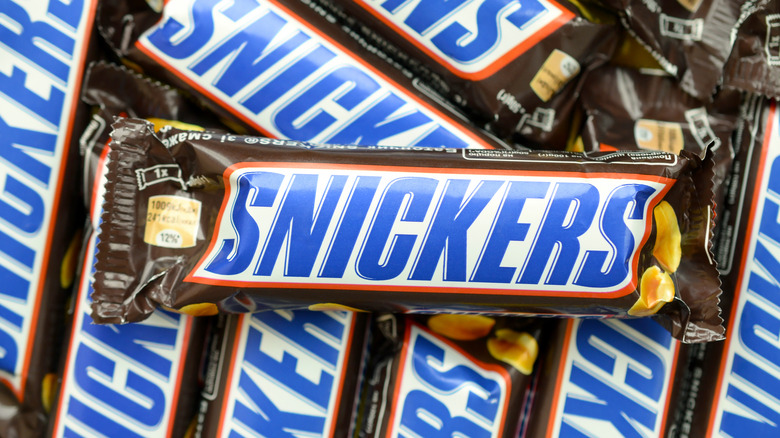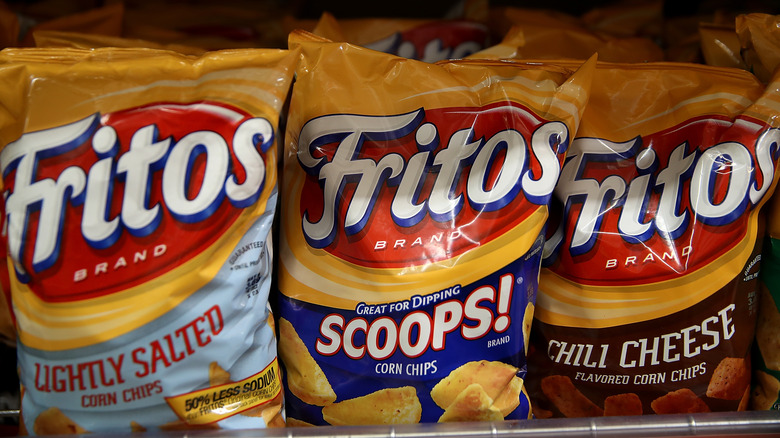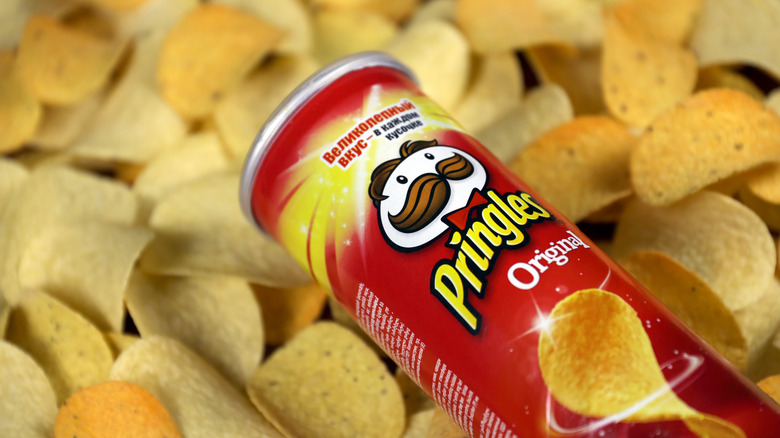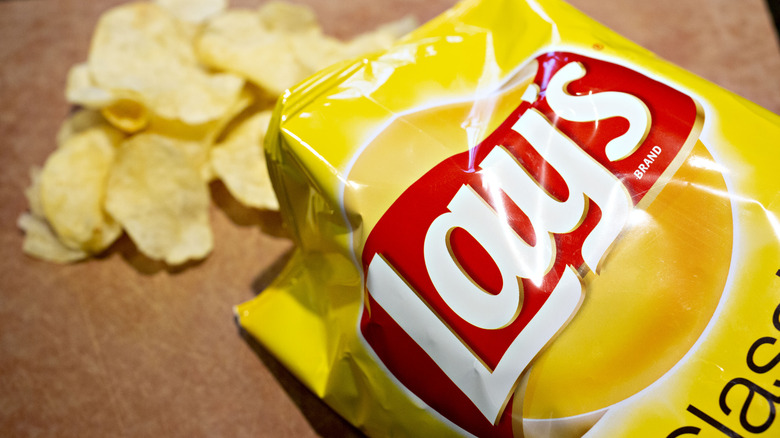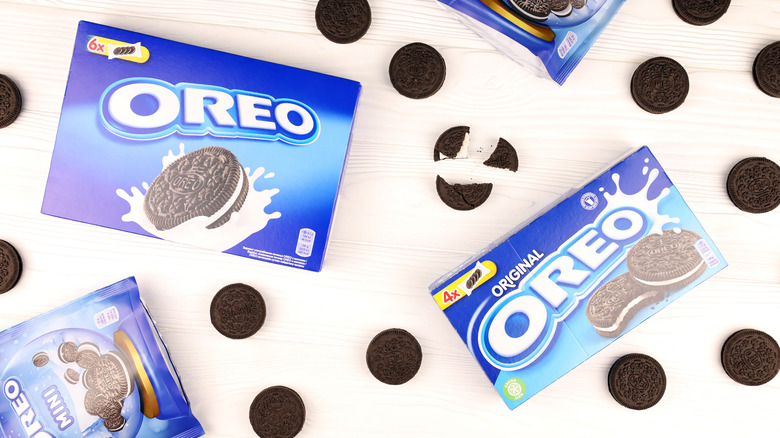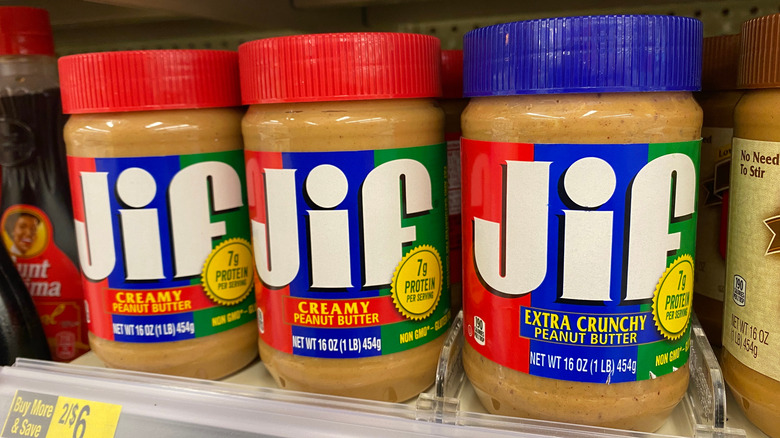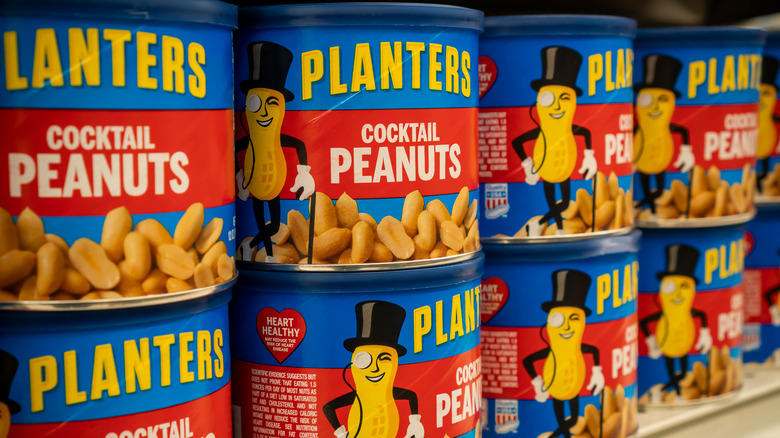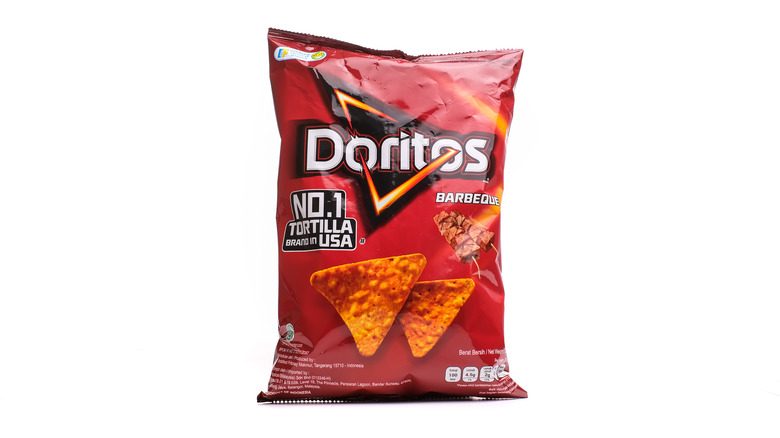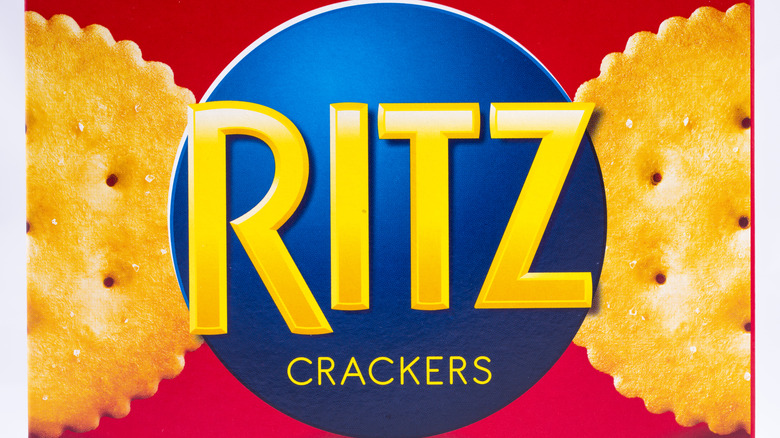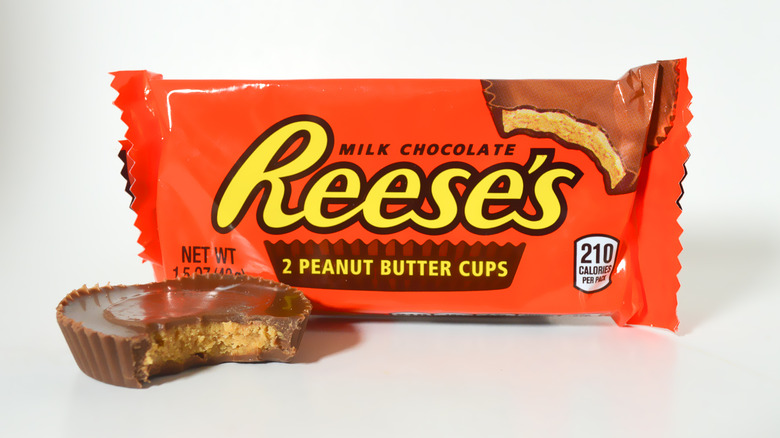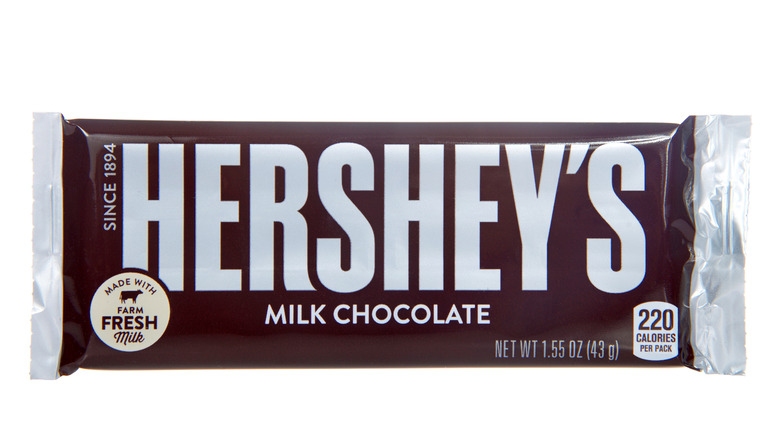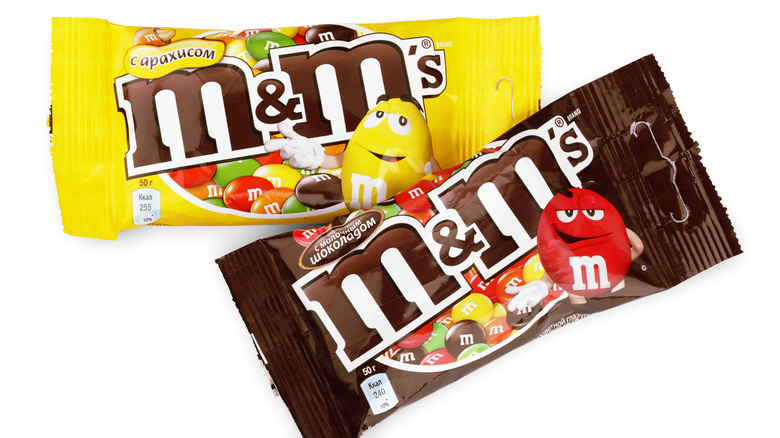The 14 Most Popular Snacks In The US
America is a nation of snackers. A study from the Institute of Food Technologists discovered that 47% of American adults eat snacks at least three times a day. We snack at all times, with substantial portions of survey respondents saying they snack morning, noon, and night. The domestic salty snack market is immense, with total sales reaching almost $25 billion in 2019. The pandemic made us snack even more, with Mondelez International's 2020 State of Snacking report finding that 46% of people have increased their snack consumption since the pandemic began. A strong majority of people now say that they eat snacks more often than they eat meals.
A solid chunk of American snack dollars go to the most popular offerings from just a few snack companies, most notably Frito-Lay, Hershey's, and Mars. Consumer research firm YouGov sought to find out America's most popular food brands by asking people which foods they felt positively or negatively about. The most iconic offerings from America's snack titans dominated the list. These are the nation's most popular snacks, as measured by consumer opinion.
14. Cheetos
Fritos mastermind Charles Edward Doolin wasn't content with revolutionizing the snack industry just once, so he experimented in his home kitchen until he stumbled upon the Cheeto (via NPR). Cheetos are partially indebted to U.S. military researchers. The Army first figured out how to create a powdered form of American cheese after WWII. Doolin sprinkled his innovative corn puffs with the Army-approved cheese dust, and a legend was born.
Cheetos' special manufacturing process produces a texture that's totally unique in the snack market. Nothing can truly replicate the experience of an original crunchy Cheeto. They're in a class all their own in terms of brand performance too, with over 75% of Americans saying they ate at least one bag of Cheetos per month in 2020 (via Statista) Whether you like crunchy or puffy, Flamin' Hot or Original, Cheetos manage to have something to offer for American snackers of all stripes.
13. Tostitos
Tostitos were the first nationally distributed restaurant-style tortilla chip in America, and they still outsell all of their competitors (via CNN). As of 2019, the original variety brought in $652.2 million for Frito-Lay, with Tostitos Scoops coming in a close second at $484.3 million (via Snack Food & Wholesale Bakery). CNN explains that tortilla chips were invented sometime in the early 20th century and became a popular snack in Mexican restaurants in Southern California. Frito-Lay decided to make its own version of tortilla chips and released Doritos, America's first pre-packaged tortilla chip. Doritos became a big hit, making tortilla chips popular nationwide.
As Doritos grew in popularity, Frito-Lay began transforming them from plain salted tortilla chips into the cheese-dusted treats we all know and love (via Huffington Post). The rising popularity of nachos in the 1970s convinced Frito-Lay to develop and launch Tostitos, a new brand of plain, salted tortilla chips perfect for covering in cheese and toppings. Unlike the Americanized Doritos, Tostitos were meant to be more like the fried tortillas Mexicans ate at restaurants and at home. Frito-Lay dominates the tortilla chip business to this day, owning the three most popular brands.
12. Snickers
According to a poll from 2019, Reese's is America's most popular Halloween candy, beating second-place Snickers by over 15% (via USA Today). However, Snickers is no slouch either, selling $127 million worth of the Halloween-friendly snack size bars, year-to-date as of June 2021, according to market research firm IRI (via Candy Industry). Mars Wrigley COO Vic Mehren told Today that Snickers and other Mars products are so popular on Halloween that the company has to plan months, or even years, ahead of time to be able to meet demand and release new products.
Like many of the snacks on this list, Snickers is a classic treat that most Americans remember from childhood. Nostalgia sells in the snack market, and people have been craving Snickers' combo of nougat, caramel, and peanuts since 1930. Americans' affection for Snickers has a limit, however, and the country didn't go along with the brand's plea to change Halloween's date from October 31 to the last Saturday in October, not even for 1 million free candy bars (via Fox News).
11. Fritos
Fritos are one of Texas' greatest contributions to American culture. According to NPR, the snack, whose name means "little fried things" in Spanish, started as a Mexican beach food. Then, during the Great Depression, San Antonio-based confectioner Charles Elmer Doolin encountered a man selling homemade Fritos at a gas station. He liked them so much that he bought the patent and the machinery, acquiring the exclusive right to manufacture them in the U.S. He changed up the recipe a little bit, obsessing over every detail. Doolin even engineered his own special corn variety to make sure his Fritos tasted exactly the way he wanted them to.
His attention to detail paid off, and the success of Fritos and his later invention, Cheetos, propelled him to the top of the American snack industry. Later, he joined forces with Herman W. Lay, the man behind Lay's potato chips, to form the snack behemoth we know as Frito-Lay.
The secret to Fritos' unique taste and texture is that rather than being made of tortillas like most corn chips, they're made of a fresh masa dough that is extruded into a fryer. Americans can't seem to get enough of that Frito crunch. Statista reports that approximately 3 out of 4 Americans eat at least a bag per month.
10. Pringles
Pringles had a rockier road to the top than some of the other snacks on this list. Potato chips became very popular during America's post-WWII economic boom, but some snackers were annoyed by the oily residue and chip crumbs that came from conventional potato chips (via Thrillist). Procter & Gamble swooped in, trying to create a better potato chip with science. P&G organic chemist Fred Baur used supercomputers and geometric formulas to come up with Pringles' unique shape and tubular package that prevented the chips from breaking. Baur was no chef, however, and his space-age chips tasted bad.
P&G didn't release Pringles until the 1960s when Alexander Liepa figured out a tastier recipe. Even then, the brand wasn't an overnight success, and Pringles limped through the next 15 years or so. They even had to change their name from "chips" to "crisps" because of a lawsuit from other chip brands. Baur's innovation paid off eventually, and Pringles sales boomed in the 1980s.
Pringles are a massive revenue driver for their current owner Kellogg's, selling $825 million year-to-date as of May 2020 (via Snack and Bakery). It took the brand a long time to get there, but now they're America's third-best-selling chip.
9. Lay's
Despite their popularity, Pringles sales are dwarfed by Lay's which holds the number one and two spots on the best-selling chips list (via Statista). Lay's founder Herman W. Lay had many things in common with his future business partner, Fritos magnate C.E. Doolin. It says in his New York Times obituary that Lay bought a down-on-its-luck snack company in the 1930s, renamed it after himself, and quickly cornered the potato chip market in the Southeast. At the time, there were no national chip companies, and Lay and Doolin were the first to sell nationwide when they partnered in 1961. If there's one thing we can learn from snack history, it's that it's good to be the first. Lay's has dominated the U.S. potato chip business since it went national in the '60s.
Just because Lay's is the oldest player in the U.S. potato chip market doesn't mean it can't be innovative, either. As we've mentioned elsewhere, Lay's is unrivaled when it comes to flavor selection, with over 160 flavors among its different chip brands. The company also stokes interest by introducing new limited-time flavors frequently and even involving consumers in the flavor creation process (via Insider). With old standbys like barbecue sharing the shelf with wacky experiments like cappuccino, Lay's chips offer something for everyone.
8. Oreos
Oreos are a big exception to the "first is best" rule, as they are a blatant rip-off of an earlier cookie called the Hydrox. Although Hydrox cookies debuted four years prior to Nabisco's "invention" of the Oreo, they were handicapped by their inferior branding and the weaker advertising budget of their parent company, Sunshine. One of Nabisco's savviest marketing ideas was to promote twisting Oreos apart to eat the cream and biscuits separately, a move that has since been emulated by generations of children. Oreos almost drove Hydrox cookies to extinction, becoming one of America's favorite snack foods.
Over the decades, Nabisco introduced delectable innovations like Double Stuf Oreos and Oreo Blizzards to keep up with the times and generate more consumer interest. Oreos solidified their place as America's favorite cookies when they ditched lard to become vegetarian and kosher in the '90s, allowing an even larger number of people to enjoy them.
Oreo producer Mondelez International celebrated a big milestone in 2019 when Oreo revenue topped $3 billion for the first time. According to the company, the U.S. consumes just under one-third of the total global Oreo production each year, eating around 10 billion Oreos annually. That's over 27 Oreos for every person who lives in the country!
7. Jif
Jif is another case where a relative latecomer usurped earlier snack food innovators. According to Peanut Butter Lovers, modern peanut butter is indebted to the inventions of Joseph L. Rosefield, who figured out in the 1920s that churning peanut butter gave it a creamier texture. He also patented a method for making shelf-stable peanut butter that lasted a year without spoiling. Swift & Company, which later became Peter Pan, was the first manufacturer to use Rosefield's techniques on an industrial scale, starting production in 1928. Four years later, Rosefield started his own company and began selling Skippy peanut butter. Procter & Gamble didn't enter the scene with Jif until 1958. Today, Jif, Skippy, and Peter Pan are still the biggest three peanut butter makers, with Jif enjoying a comfortable lead over its competitors.
Jif's current owner, J.M. Smucker Company, told WKYT News in 2018 that Jif uses 10% of all U.S. peanut production. Given that Jif is America's favorite peanut butter, it's no surprise that its factory in Lexington, Kentucky holds the world record for largest peanut butter plant. Smucker needs a lot of space to produce the 270 million pounds of Jif that people in the U.S. eat every year.
6. Planters
Planters sells a wide variety of products these days, but its core offerings still consist of simple mixed nuts, primarily peanuts. You wouldn't expect such basic snacks to thrive in the 21st century when we have so many exciting treats to choose from, but Planters is a heavy hitter, with annual sales of about $1 billion in 2020 (via St. Paul Business Journal). The history of Planters is a real rags-to-riches tale, starting with founder Amadeo Obici landing in New York as an 11-year-old Italian immigrant who didn't know any English. As an adult, Obici turned his simple peanut vendor stall into a huge corporation, promoting peanut consumption to the masses throughout the Great Depression and WWII.
Much of Planters' success came from its innovative marketing campaigns featuring Mr. Peanut. The National Museum of American History notes that the iconic mascot was dreamed up by a teenager named Antonio Gentile, who earned $5 for creating one of the most successful characters in advertising history. Mr. Peanut gave Planters a strong brand identity compared to other peanut sellers, encouraging customers to choose Planters over competing nut manufacturers.
5. Doritos
Today we associate Doritos with a rainbow of wild flavors and with mashups like the Doritos Locos Taco. But when they debuted, the chips were very simple. The Huffington Post reports that the original Doritos were basic salted tortilla chips that tasted like toasted corn. Seasoning dust didn't enter the picture until a year after the chips launched nationally, with the Taco flavor hitting shelves in 1967. Nacho cheese, the most popular Doritos flavor in history, got its start in 1972.
There are multiple theories about the true inventor of the Dorito, but Frito-Lay executive Arch West has one of the strongest claims to the title. Even if West didn't invent the snack, he was the brand's number one fan throughout his life, so much so that when he passed away, his family decided to scatter Doritos over his grave.
The addictive mix of crunchy texture and savory seasoning makes Doritos far-and-away the most successful tortilla chip brand in America, selling $2.4 billion worth of chips in 2019, almost four times as much as the second-place finisher (via Snack Food & Wholesale Bakery). We just can't get enough of that powerhouse combo of salty, fatty, and umami.
4. Ritz
Ritz crackers might have fallen a few spots in the polls since Insider declared them "America's Favorite Snack" in 2012, but they're still near and dear to the hearts of U.S. snackers. According to Statista, nearly 70 million Americans ate Ritz in 2020. Baking Business says that the pandemic has been a boon for legacy snack brands like Ritz, making consumers reach for the comfort of familiar tastes during this time of global uncertainty.
Like Nabisco's other entry on this list, Oreos, Ritz crackers began life as an imitation of a Sunshine Biscuit product. Ritz are a close copy of Sunshine's Hi Ho butter crackers. Consistency has always been a big part of Ritz's appeal, with Nabisco priding itself on being able to deliver crackers that tasted bakery fresh even after spending months on the shelf. The company's innovative Inner-Seal packaging design ensured Ritz stayed crispy and delicious, giving the brand a leg up over traditional crackers sold in bulk (via History of Branding). Ritz became America's best-selling butter cracker within a few years of their release, and they still hold the top spot almost a century later.
3. Reese's
Reese's cup inventor Harry Burnett Reese wore many hats before he got into the candy business. He hopped from job to job looking for a gig that would earn enough money to feed his 16 children (via Insider). Reese eventually found steady employment under chocolate baron Milton Hershey, working as a farmer at a Hershey-owned dairy operation and then laboring in a chocolate factory. Inspired by his successful boss, Reese began making candy in his home kitchen and selling it as a side hustle. His daughter Mary Elizabeth told the Hershey Archives that his first forays into confectionery failed to find success. He tried making hard candies in 1919, but the recipe was off and they stuck together. Then he moved on to a chocolate bar, but the sugar in the bars crystallized. Reese started having local success in the '20s, when he began selling a variety of fillings enrobed in Hershey's milk chocolate. Candy shortages during WWII made him focus on his best-seller, the peanut butter cup. After his death in 1956, his sons sold the operation to Hershey's.
Now Reese's Peanut Butter Cups are Hershey's best-selling product, moving units to the tune of $671 million year-to-date as of June 2021 (via Candy Industry). They're a trick-or-treating classic, and special holiday variants on the original cup help drive sales throughout the year. Sometimes the simple things are the best, and the marriage of chocolate and peanut butter works every time. It's a match made in heaven, and there's even scientific data to prove it.
2. Hershey's
Food Dive reported that consumers bought $1.6 billion worth of Hershey's chocolate bars in 2020. The company as a whole earned $8.15 billion in sales in 2020, according to Statista. That loyalty from customers is reflected in the YouGov list, with the Hershey's brand as a whole coming in at number two and Hershey's products like Reese's and Kisses also making appearances. Hershey's is the oldest candy bar on this list, debuting all the way back in 1900. Company founder Milton S. Hershey had started in the caramel business, but his small operation turned into an empire when he switched to making milk chocolate (via Britannica). Three years after he introduced his famous chocolate bar, Hershey broke ground on the largest chocolate factory in the world. Hershey's was so important to the economy in its home state of Pennsylvania that it spawned its own town, Hershey, where workers at the candy plant lived.
Hershey's solidified its place in the pantheon of great American snacks by helping out the war effort during WWII. The company modified its signature chocolate bar to produce Field Ration D, an emergency food that resisted melting (although it didn't taste as good as the civilian Hershey's bar). According to Hershey's, they stopped making Kisses during this time to save aluminum during the war, resuming production in 1947.
1. M&M's
According to YouGov's polling, more Americans have positive feelings about M&M's than any other candy. Sales data backs that up, with M&M's leading the pack in the over 3.5 oz. category with $989.7 million in revenue year-to-date as of June 2021 (via Candy Industry). Close to a billion dollars of business isn't bad for such a tiny candy!
M&M's have shown up at critical moments throughout American history. They gave sustenance to U.S. troops in WWII, suspending civilian production to meet wartime demand (via History). During this period, M&M's were actually made using Hershey's chocolate, a result of a wartime partnership that ensured an adequate supply of candy-making materials. These days, M&M's parent company Mars is one of Hershey's biggest rivals in the chocolate industry. M&M's tidy candy coating makes them perfect for adventures, even extraterrestrial ones. The candy went into orbit during NASA's first space shuttle launch. From the battlefield to the upper atmosphere, M&M's are one of the few things every American can agree on. Just don't ask whether peanut or original is better, because then you might start a fight!
